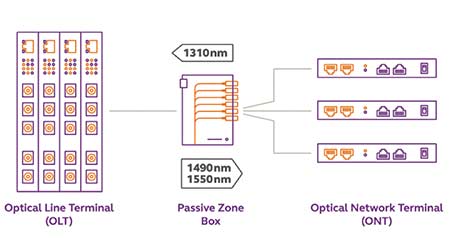 In a passive optical LAN system, an optical line terminal converges data, voice and video. This travels to a passive zone box, which contains optical splitters. One fiber splits into 32. At the workstation, an optical network terminal provides gigabit connectivity.
In a passive optical LAN system, an optical line terminal converges data, voice and video. This travels to a passive zone box, which contains optical splitters. One fiber splits into 32. At the workstation, an optical network terminal provides gigabit connectivity.SIDEBAR: Use Available Technology To Optimize the Office
A high-performance facility infrastructure is required to accommodate increasingly high-performance technologies.
High performance in the workplace is not created by technology, but it is facilitated by technology. And as the workplace becomes more and more intelligent through deployment of Internet of Things technologies or more capable video conferencing technologies, the facility’s data backbone becomes a crucial component of the conversation. “These high-performance technologies require a high-performance facility infrastructure,” says Darren Vican, vice president at CallisonRTKL and leader of the firm’s technology design studio.
Traditional copper, such as Cat5, has a distance limitation of around 295 feet to deliver 1 gigabit to the desktop, he says. This necessitates all the data infrastructure facility managers are well familiar with: data closets, conduit, cable trays, etc., as well as the facility infrastructure for those spaces, like cooling.
An alternative is passive optical LAN (POL), says Vican. POL is not a new technology, originally developed for the telecom market, but it is still gaining ground in the enterprise. It uses small single-mode fiber optic cable and transfers data from the data center to the desk in runs almost up to 20 km.
“Now we can reach any point in a campus with one technology room, without adding another technology space, no distributed electronics or additional power and cooling,” says Vican.
According to Vican, there is currently no known upper limit to the bandwidth capability of single-mode fiber, with products currently available that can deliver 10G to the desktop. This allows the facility backbone to remain in place even as the end-user technology at the desktop or conference room evolves and requires greater bandwidth.
In addition to increased longevity and capacity of the facility backbone, fiber has an initial cost advantage to copper, and eliminating technology support spaces and infrastructure increases available square footage.
Related Topics:
















